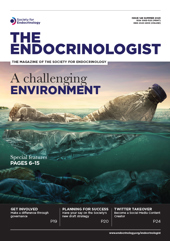Endocrine-disrupting chemicals (EDCs) are man-made compounds that can interfere with any aspect of hormone signalling.1 Humans regularly come into contact with EDCs in daily life, through their presence in household products, plastics, personal care products and pesticides, and through our diet.
Examples of EDCs include bisphenol A (BPA) used in plastics, phthalates in cosmetics and intravenous tubing, industrial and commercial chemicals that contaminate food, and perfluoryl alkyl substances (PFAS) in consumer products. PFAS are particularly noteworthy because they are considered ‘forever chemicals’, due to their high persistence and ability to accumulate in the body.
‘Pregnant rats exposed to the fungicide vinclozolin had male offspring that developed latent reproductive disease.’
Because EDCs can interfere with hormone actions through a variety of mechanisms, including hormone release, transport, signalling, metabolism and degradation,2 these chemicals have the potential to contribute to, or even cause, diseases and dysfunctions of the endocrine system and its targets, including the brain.
EDCs ARE LINKED TO ADVERSE HEALTH OUTCOMES
Although there is overwhelming evidence and acceptance that environmental factors, such as EDCs, lead to increased disease burden,3 it is difficult to prove a cause-and-effect link between exposure to a specific chemical and a negative health outcome. Despite this, several lines of evidence give strong confidence that EDC exposures predispose to endocrine and neurological diseases.
1. The prevalence of obesity, diabetes, thyroid disease and neurobehavioral problems, among others, has increased in parallel with the increased manufacture of organic chemicals.
2. Incidents involving known human exposures to specific chemicals, as happened with contaminated cooking oil in Japan and Taiwan, have revealed neurobehavioural and other problems in the children of exposed mothers.
3. Epidemiological studies have consistently linked higher body burdens of EDCs, typically measured in serum, urine, amniotic fluid or umbilical cord blood, to various endocrine and behavioural disorders.
4. Animal models of exposure to a chemical or mixture, and subsequent manifestation of an endocrine problem, can reveal not only causality, but also potential underlying mechanisms. This last body of work, performed mainly in rats and mice, is highly translational to humans, because the biological processes by which hormones act are conserved across all mammals, and indeed all vertebrates.
THE SPECIAL VULNERABILITY OF THE FETUS AND INFANT
The field of environmental health has long recognised the particular sensitivity of developing organisms to environmental contaminants and stressors. This discipline, referred to as the ‘developmental origins of health and disease’,4 is foundational to endocrine and neurological health. During these life stages, often referred to as critical periods, the organism is rapidly developing and hormone actions are tightly regulated. Indeed, deviations from appropriate hormone levels can permanently affect a developing organism in a manner that may set a trajectory for a lifetime of function or dysfunction.5,6
EDCs CAN EXERT THEIR ACTIONS ACROSS GENERATIONS
Clearly, EDCs have direct effects on an organism. However, this may not end with the individual. In 2005, it was reported that pregnant rats exposed to the fungicide vinclozolin had male offspring that developed latent reproductive disease. Furthermore, their offspring (the grandchildren) and the subsequent generation (great-grandchildren) also had disease phenotypes.7 Numerous studies since then have demonstrated multigenerational obesity, behavioural and reproductive problems, and other issues.8,9
'Most human exposure is through the diet, and there are several behavioural changes that can help.'
This research has been referred to as transgenerational epigenetics, because the mechanism of heritability is non-genomic (i.e. not due to DNA mutation) but, rather, due to a heritable epigenetic mark such as DNA methylation, histone modifications or non-coding RNAs.5
WHAT CAN WE DO TO MINIMISE EXPOSURE TO EDCs?
It may seem hopeless to avoid EDC exposures due to their ubiquity, but it is possible to reduce contact. In the case of personal care products, consumers can consider looking for cleaners and cosmetics that have fewer added chemicals and scents. When using sunscreens to filter out UV rays, choose products with ingredients such as zinc oxide and titanium dioxide, rather than chemical sunscreens.
Most human exposure is through the diet, and there are several behavioural changes that can help. When eating fresh produce, wash thoroughly (tap water is generally fine) to remove pesticide residues. It is always recommended to eat fresh rather than processed food. Processing can add chemicals, even inadvertently, when food is prepared. Moreover, food packaging is a major source of chemicals due to leaching, particularly when heated. Never microwave food in plastic – rather, transfer to a ceramic, glass or similar container.
We should take particular care to minimise purchasing food in non-reusable containers such as plastic beverage bottles. These contribute to the world’s burden of plastics,10 and most are either not recycled at all or are only partly recycled. Using a refillable, non-plastic container avoids contributing to that cycle. Furthermore, filtered tap water is readily available in most places and is an excellent way to improve environmental health.
ANDREA C GORE
Professor and Vacek Chair in Pharmacology, University of Texas at Austin, TX, USA
REFERENCES
1. Zoeller RT et al. 2012 Endocrinology 153 4097–4110.
2. La Merrill MA et al. 2020 Nature Reviews Endocrinology 16 45–57.
3. Gore AC et al. 2015 Endocrine Reviews 36 E1–E150.
4. Barker DJ et al. 2022 International Journal of Epidemiology 31 1235–1239.
5. Streifer M & Gore AC 2021 Advances in Pharmacology 92 73–99.
6. Kay JE et al. 2022 Current Environmental Health Reports 9 535–562.
7. Anway MD et al. 2005 Science 308 1466–1469.
8. Robaire B et al. 2021 Environmental Research 204 112063.
9. Walker DM & Gore AC 2011 Nature Reviews Endocrinology 7 197–207.
10. Landrigan PJ et al. 2023 Annals of Global Health 89 23.






